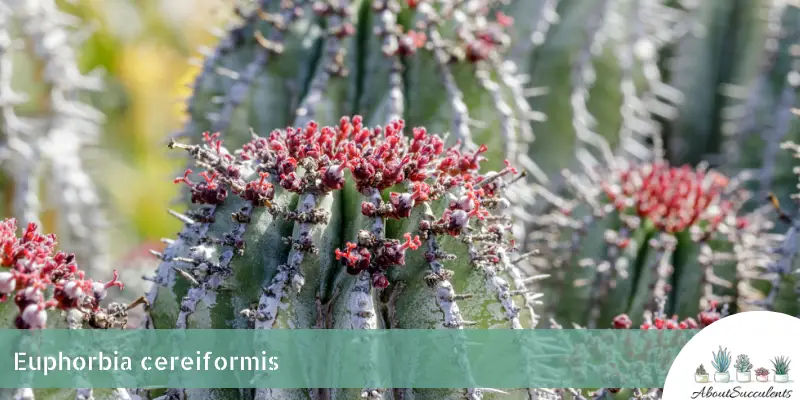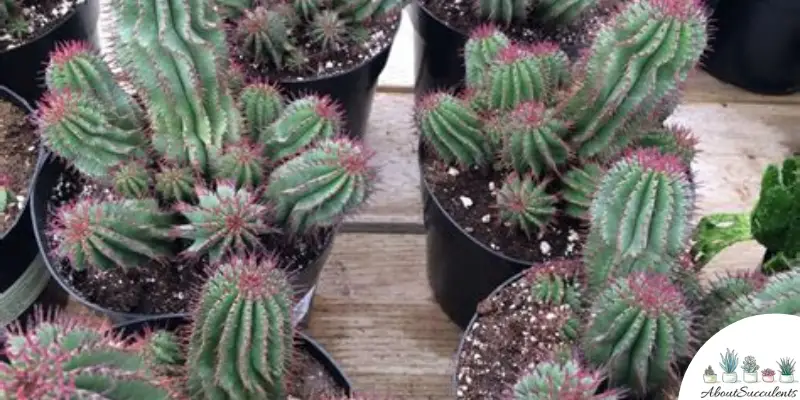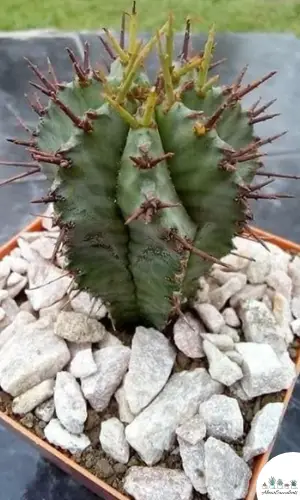
Euphorbia cereiformis, also known as ‘Milk Barrel Cactus’ is an eye-catching, densely-branched, spiny, columnar succulent that produces many offsets that clump and spread out.
Euphorbia cereiformis’ thorns give it the look of a plant straight out of the prehistoric age. The delicate flowers that bloom on top of the cactus makes a nice contrast that will make your guests jokingly ask if this plant is from another planet.
The Milk Barrel Cactus has green, club-shaped branches adorned with up to 15 narrow ribs. The ribs have serrated edges covered with brownish-red spiky peduncles or dried flower stalks that grow up to 2cm (0.79”) long.
This succulent shrub can grow up to 90 cm (36″) tall and up to 10 cm (4”) wide. In late winter or early spring, Euphorbia cereiformis blooms a crown of burgundy flowers.
Euphorbia cereiformis originates from the Cape Province, South Africa. It is part of the Euphorbia genus of the Euphorbiaceae family.
General Information
Also known as: Milk Barrel Cactus
Family: Euphorbiaceae
Origin: Cape Province, South Africa
Height: 90 cm (36″)
Exposure: Full Sun to Partial Sun
Water Needs: Drought-resistant; use ‘soak and dry’ watering method
Soil Type: Cactus potting mix combined with gritty materials such as perlite, coarse sand, and pumice.
Soil pH: 6.1 to 7.8
How to Grow and Care for Euphorbia Cereiformis

Euphorbia cereiformis is very easy to grow and care for. It can be used to create attractive indoor container gardens or outdoor cactus gardens.
Milk Barrel Cactus is not cold-hardy and will not survive at temperatures below -1.1°C (30° F). It grows best at temperatures of 18°C to 26°C (64°F to 78°F).
Does your region experience frosty weather? If so, grow Euphorbia in a pot that can be transferred from the garden to your home.
Sunlight
Euphorbia cereiformis loves plenty of bright light. If planted outdoors, choose an area where it will be exposed to full to partial sunlight for 6 hours in the early morning or late afternoon.
If kept indoors, place the container near a south-facing or south-east-facing window where it can get 5 to 6 hours of indirect sunlight.
Low light exposure will result in your plant’s stunted growth or etiolation. A condition where the stems will stretch out to seek a light source. If you do not have an area in your house with sufficient lighting, get a grow light
Watering

Euphorbia cereiformis is a drought-tolerant plant. It should be watered only when ¼ part of the soil has dried out.
The ‘soak and dry’ watering method suits ‘Milk Barrel Cactus’ best. When watering, soak the soil until excess water flows out of the drainage holes. Before watering again, insert your finger 2 inches deep into the soil to see if it has dried out.
When it is actively growing during summer till spring, water your succulent once a week.
Water your plant less frequently when winter comes because the soil retains moisture longer during this season. Remember to keep tabs on your schedule to avoid overwatering.
Giving the soil water while there’s still a good amount of moisture will put the roots at the risk of rotting.
If the roots start to rot, it will only be a matter of time before its cells rupture and leave Milk Barrel Cactus at risk of developing a fungal infection.
Pot and Soil
The best pots to use for Euphorbia Cereiformis are made of terracotta or ceramic. These materials allow proper soil aeration and prevent water retention. Get pots that have drainage holes to allow excess water to flow out.
Succulents require well-draining soil. Milk Barrel Cactus will thrive best in organic matter such as peat moss or coir, combined with gritty materials such as perlite, coarse sand, and pumice.
You can also use store-bought cactus or succulent potting soil mix combined with gritty materials to improve drainage.
Most potting soils contain enough nutrients needed by your plant to grow well. But, you can add cactus fertilizer once a month during spring and summer when your plant is actively growing.
How to Propagate Euphorbia Cereiformis
Euphorbia cereiformis is a fast-growing succulent that can be propagated using its offsets that grow around the base of the plant.
You need to be careful in handling the offsets because the white sap can irritate your skin. Make sure to wear nitrile-dipped gloves.
Method 1 – Offsets
Step 1: Use a silicone tong to hold and twist the offset. Gently pull it away from the mother plant.
Step 2: If you cannot pull out the offset from the mother plant, use a sterile sharp knife to cut through the stem. Cut the stem as close to the mother plant as possible.
Step 3: Leave the offsets in a well-ventilated, dry area for a few days to allow them to callous over.
Step 4: Place the container of the mother plant in a shaded area for recovery.
Step 5: Repot the offsets in terracotta or ceramic pots filled with cactus potting mix combined with gritty materials. Wait a week before watering the soil.
Step 6: If you will replant them in a garden bed, let them root first in a shallow container filled with cactus mix topped with 5cm (2”) coarse sand. Water the soil once a week. Once the roots have grown, replant the offsets in the garden bed.
Frequently Asked Questions
Is Euphorbia Cereiformis Toxic to Cats and Dogs?
Euphorbia cereiformis is not included in the list of plants that are toxic to cats and dogs on the website of the American Society for the Prevention of Cruelty Animals (ASPCA).
However, this is an incomplete list and all the parts of Euphorbia cereiformis can be harmful to the body if ingested. We recommend keeping pets away from your plant.
The white sap inside the stems can also cause skin irritations or allergic reactions so wear gloves when handling your Milk Barrel Cactus.
Why is My Euphorbia Cereiformis Dying?
If your Euphorbia cereiformis looks lifeless and shows symptoms of disease, the causes could be overwatering and pest infestation.
It’s not the end of the world – or your plant. You can still resuscitate Milk Barrel Cactus if you act quickly.
Overwatering
Excessive watering of your Milk Barrel Cactus will cause its roots to rot quickly. If you notice brown spots on the stems and some parts turning mushy, treat your plant immediately to prevent further damage.
Lightly moisten the soil. Wear gloves and gently remove the whole plant from the pot or garden bed. Gently brush off the soil from the roots.
Examine the roots and other parts carefully and cut the rotted ones with a sterile sharp knife or pruning shears. Lay the plant in a warm and dry area and allow the cuts to callous over for several days.
Fill a terracotta pot filled with cactus mix and gritty materials. Replant your Milk Barrel Cactus and wait a week before you water the soil.
Pest Infestation
Euphorbia cereiformis is vulnerable to mealybugs and scales infestation. You need to remove these sap-sucking pests as soon as you detect them.
Isolate your infected plant. Spray it with diluted neem oil or 70% rubbing alcohol. Repeat daily for one week or until you get rid of all the pests.
If the infestation is mild, remove the pests with tweezers or dab them with a cotton swab dipped in 70% rubbing alcohol.
Euphorbia cereiformis produces a crown of burgundy flowers in late winter or early spring.
Last Updated on June 9, 2022 by Sofia Lara